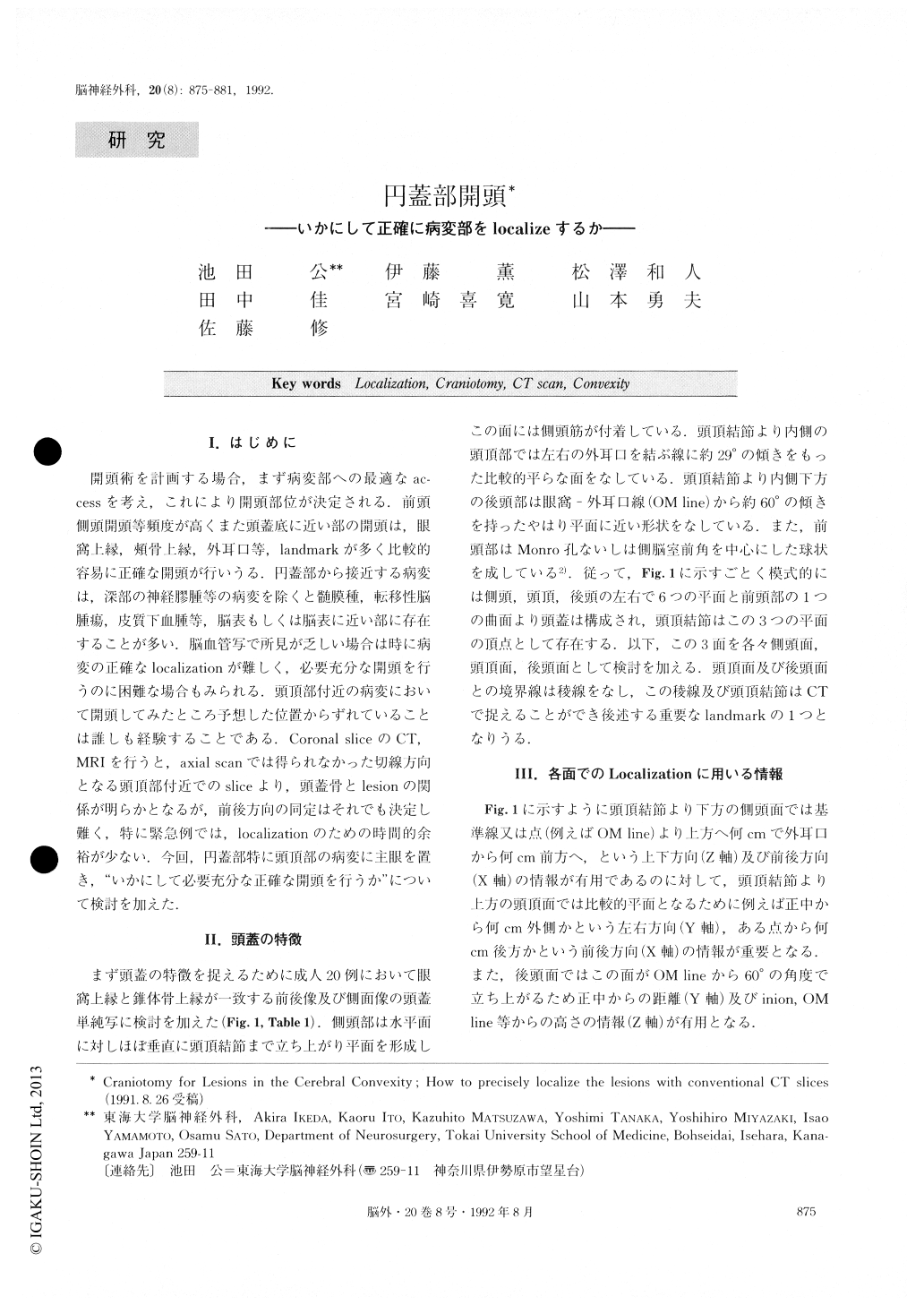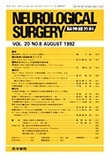Japanese
English
- 有料閲覧
- Abstract 文献概要
- 1ページ目 Look Inside
I.はじめに
開頭術を計画する場合,まず病変部への最適なac—cessを考え,これにより開頭部位が決定される.前頭側頭開頭等頻度が高くまた頭蓋底に近い部の開頭は,眼窩上縁,頬骨上縁,外耳口等,landmarkが多く比較的容易に正確な開頭が行いうる.円蓋部から接近する病変は,深部の神経膠腫等の病変を除くと髄膜種,転移性脳腫瘍,皮質下血腫等,脳表もしくは脳表に近い部に存在することが多い.脳血管写で所見が乏しい場合は時に病変の正確なlocalizationが難しく,必要充分な開頭を行うのに困難な場合もみられる.頭頂部付近の病変において開頭してみたところ予想した位置からずれていることは誰しも経験することである.Coronal sliceのCT,MRIを行うと,axial scanでは得られなかった切線方向となる頭頂部付近でのsliceより,頭蓋骨とlesionの関係が明らかとなるが,前後方向の同定はそれでも決定し難く,特に緊急例では,locahzationのための時間的余裕が少ない.今回,円蓋部特に頭頂部の病変に主眼を置き,“いかにして必要充分な正確な開頭を行うか”について検討を加えた.
A simple direct precise localization with a CT scan for convexity lesions is presented. The shape of the normal calvarium was analyzed and a characteristic pattern was obtained, that is, one spherical surface in the frontal area and 6 flat planes in the temporal, parietal and occipital areas. The temporal plane is per-pendicular to the orbito-meatal line (OML) , while the parietal plane declined 29 degrees in the A-P view, and the occipital plane declined 60 degrees in the lateral view. A summit of these three planes forming the parietal tubercle, and the crest following the tubercle between the parietal and occipital planes were detected either by CT scan, or by palpating the skull. Conventional methods of preoperative localization in-clude measurement and calculation from the base line such as OML, or obtaining a CT scan with a marker on the scalp. The former might have an error that will be amplified in the parietal region that would not be neg-ligible. The latter is a rather troublesome method de-manding that the CT scan be taken after shaving the hair.
Landmarks utilized for the localization should be identified both on the CT scan and on the scalp or skull. These involved OML, coronal suture, parietal tubercle, inion, pineal body, midline and so on. Of these, the coronal suture runs almost perpendicular to the OML and would be the best landmark for the loca-lization in the parietal area. In this area, measurement on the CT scan of distances from the midline, and from this suture to the lesion or to the center of craniotomy, and its application to the skull, facilitates the precise localization. This can be achieved with only one slice.One of the most important pitfalls for the localization in the parietal plane is that the precise center of the craniotomy seen on the CT scan should be higher (i.e., more medial) than the center of the lesion because of the inclination of the parietal plane.
The authors' way for determining preoperative loca-lization is as followings : In the temporal plane Z axis - height from OML or pineal body X axis - AP distance from the meatus or pineal body In the parietal plane Y axis - distance from the midline X axis - distance from the coronal suture and/or parietal tubercle In the occipital plane Z axis - height from the inion, OML or pineal body Y axis - distance from the midline.

Copyright © 1992, Igaku-Shoin Ltd. All rights reserved.


